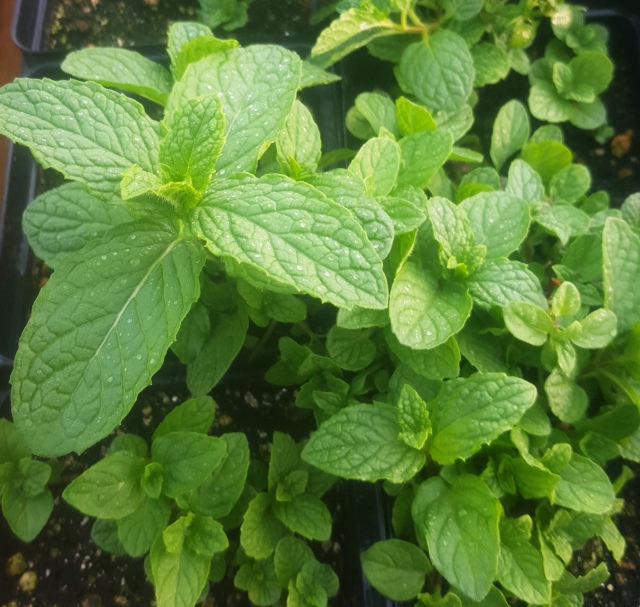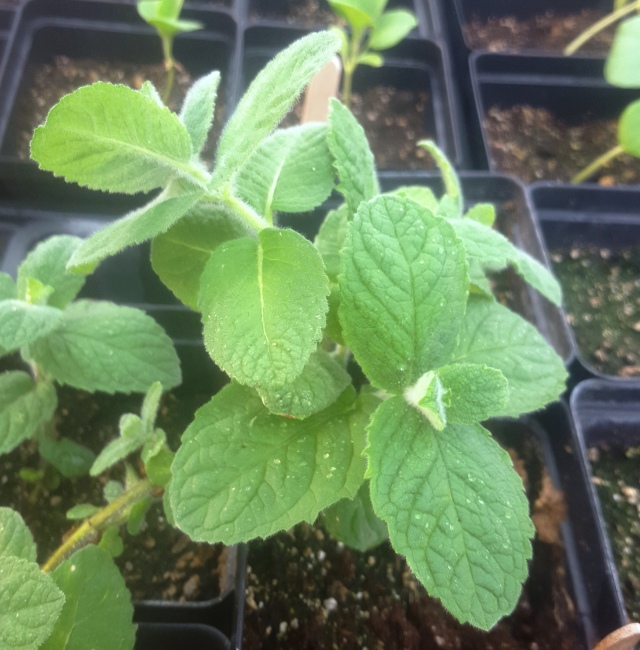Mints are old souls. The origins of the name mint predate Ancient Greek, and Greek mythology tells the story of how the mint plant came to be: Minthe, a water nymph, dared to seduce Hades, the God of the Underworld. Hades’ girlfriend Persephone caught on and put a stop to it by transforming Minthe into a plant. And so mint is not only aromatic but also a lesson in why it’s best not to seduce another woman’s man, especially when that woman is the Queen of the Underworld.
Most mint species are native to Europe and Asia, although some hail from the American, African, and Australian continents. In today’s world mint can be found growing outdoors in all but the coldest regions of the planet. The lines demarcating the various species of mint are sometimes not so clear, and so you’ll read that there are anywhere from 15 to 25 different species in this plant genus. But that’s just the species count. Mint varieties also arise when species hybridize (cross) either randomly in nature or deliberately in human horticulture, and then there are the mint varieties arising form cultivars, which are mint plants selected for specific characteristics that can be maintained via propagation.
What all this means is that these days at your local markets you can find a stunning array of amazing mint varieties, ranging from basic spearmint to drink mints such as mojito mint to peppermints such as chocolate mint to fruity mints such as orange mint. The Pickle Creek lineup of mint seedlings includes spearmint, mojito mint, Moroccan mint, Kentucky Colonel mint, apple mint, orange mint, lime mint, pineapple mint, ginger mint, banana mint, catmint, wintergreen mint, peppermint, and chocolate mint. We also grow other varieties from time to time when they catch our fancy. We’re always open to growing a new mint, and new mints are always to be found!

Moroccan Mint.
In the Kitchen
Mints are famous for making drinks known for sipping, including herbal teas and spirited mixes such as juleps and mojitos. You’ll also find mint in many Middle Eastern dishes (especially lamb dishes) as well as in Thai recipes, and it makes a great addition to chopped salads, fresh fruit salads, or even ice cream. We like to make jellies out of several of our mint varieties, and chocolate mint is one of our best-selling herbal jellies. Mint jelly shines best, I think, when it is served on whole-wheat crackers with a little cream cheese.

Spearmint.
On the Skin
Menthol is the compound found in mint essential oil that gives the plant its distinctive flavor and aroma. Menthol is analgesic and cooling, and for this reason mint is a time-honored addition to topical pain remedies. Menthol is an active ingredient in Bengay, and we ourselves use mint in our Deep Relief Salve, which also contains capsaicin (from hot pepper) and comfrey root and is a good natural remedy for muscle and joint pain (such as that caused by arthritis). Mint is also good for relieving itching, and it is stimulating to the senses. Thus Pepppermint Soap is a great soap for a morning shower, and a peppermint foot soak is an enjoyable way to coax life back into tired toes.

Chocolate Mint.
In the Belly
Mint (especially peppermint) has also been long touted as a soother for upset digestive systems, and research for its use in these cases is ongoing. On the other hand, if you experience acid reflux, you’ll most likely want to minimize your mint intake (especially in after-dinner mints), as it can trigger heartburn. If you’re not sure what’s causing your stomach pain (digestive issues versus acid issues), you’re probably better off not drinking your mint tea.

Apple Mint.
In the Garden
Occasionally I get questions from market customers for which I don’t have a good answer, even after 12 years of market herb gardening. One of these stumpers is, “I killed my mint plant. Mint must be really hard to grow. How do you think I killed it?”
I don’t honestly know how you kill mint except for just not watering it. Ever. Most gardeners find that it’s more difficult not to grow mint than it is to grow mint. One year in early May I put a pot of chocolate mint outside the greenhouse door, just to get it out of the way. By June the little plant had sent runners out through the water drainage holes in the bottom of the container, and by August I had a nice little thatch of chocolate mint growing along the front of our greenhouse. Whenever we mowed the grass, it smelled amazing! We still have chocolate mint there to this day.
My standard advice when it comes to growing mint is to give your plant some space, some light, some water, and then stand back and let it do its thing. Mint thrives around water, and so it takes more water than other herbs such as rosemary, lavender, and thyme take. But you’ll know when your mint needs water, as its large leaves will start to droop when it’s getting dry. Give your plant a drink, and it should bounce right back. It’s a perennial here in Iowa (zone 5), and while it will die back every winter, it will appear again in early spring. If you don’t want to risk a mint rampage, keep it in a container. We plant ours in raised beds lined with used plastic we got from the organic dairy farmer down the road.
The other thing I recommend when it comes to growing mint is to begin by buying a plant. Mint varieties must be grown from cuttings. If you start mint from seed, you will end up with common mint, which doesn’t have as good a flavor as the other mints have. In addition, I recommend buying a mint plant that has a name other than just plain “Mint.” Plain mint frequently is just common mint, which again is the least exciting kind of mint. Hence the name. Ultimately, however, it’s your garden. With such a wide selection available, you can choose the mint variety that best suits you!

